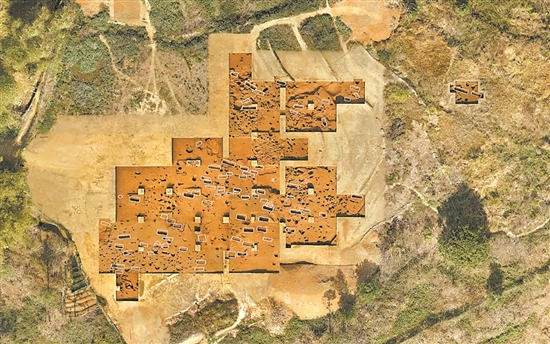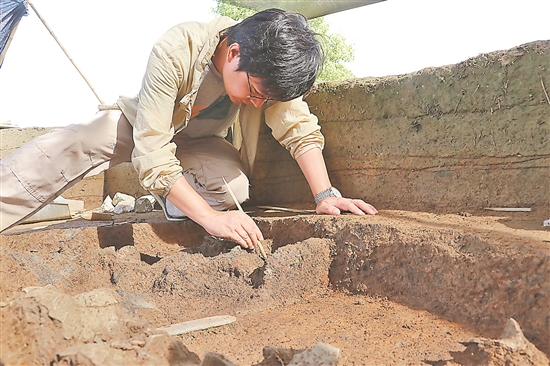The top ten new archaeological discoveries in the country in 2023 have been announced, and the coverage of time and space is unprecedented.
Text/Yangcheng Evening News All-Media Reporter Literature and Art Photo/Guangdong Provincial Institute of Cultural Relics and Archaeology
From March 21 to 22, the final review of the top ten archaeological new discoveries of the 2023 National sponsored by China Cultural Relics Newspaper and the Chinese Archaeology Society was held in Beijing. After project report and comprehensive review, the judges finally voted to select the top ten new archaeological discoveries in the country in 2023. Guan Qiang, deputy director of the State Administration of Cultural Heritage and vice chairman of the Chinese Archaeological Society, announced the final results. The top ten projects selected were (sorted by year and night): Yishui Bashan Site Group in Shandong, Jiqiutou Site Group in Pingtan, Fujian, Mopanshan Site in Langxi, Anhui, Qujialing Site in Jingmen, Hubei, Wangzhuang Site in Yongcheng, Henan, Shangdu Academy Street Cemetery in Zhengzhou, Henan, Qingjian Zhaigou Site in Qingjian, Gansu, Sijiaoping Site in Chencun, Huozhou, Shanxi, and Chencun Porcelain Site in northwest of the South China Sea.
Yanshanzhai changed the academic community’s understanding of the origin process of Lingnan civilization
The reporter learned from the final review meeting that Neolithic archaeology will have fruitful results in 2023, so the competition for projects during this period is particularly fierce. Among the 22 final review projects, 8 of the 22 final review projects belong to the Neolithic Age, and 4 were finally selected. Chen Xingcan, a representative of the judges and researcher and director of the Institute of Archaeology, Chinese Academy of Social Sciences, emphasized that the 22 projects entering the final review have important academic value and great scientific significance, regardless of whether they are finally selected or not.
Chen Xingcan took the “Guangdong Yingdeyan Mountain Village Site” in the Neolithic Age as an example and believed that the Yanshan Village Site changed the understanding of the origin of civilization and the social complexity of the Lingnan region. “We lacked the understanding of Lingnan in the past. Now, it entered a complex social stage 4,800 years ago. The origin of civilization is actually synchronized with the middle and lower reaches of the Yangtze River, which has greatly changed our understanding of the degree of social development in this region.” He said.
He also introduced in his answer to the question of the Babaylan that the 22 projects shortlisted for the final review this year covered a wide range of time and space, ranging from the “Tibet Gejimeilongdapu Cave Site” in the Paleolithic Age 100,000 years ago to the “Hongshi Mazi Site in Panshi City, Jilin Province” eighty or ninety years ago. This is unprecedented in terms of time. Meanwhile, 22 projects range from the southeast coast to the northwestThe underwater sinking ship from the 4700-meter Qinghai-Tibet Plateau to the northwest slope of the South China Sea is 1,500 meters underwater, with a vast space range. The 22 final evaluation projects also reflect outstanding characteristics such as multidisciplinary cooperation, meticulous excavation, and unprecedented improvement in cultural relics protection awareness.
The earliest complex society that can be confirmed in Lingnan area
The Yanshanzhai site is located in Lan Village, Qingtang Town, Yingde City, Qingyuan City, Guangdong Province. It is located in the middle of the mountainous area in northern Guangdong and the Pearl River Delta, with an area of about 100,000 square meters. From 2019 to 2023, the Guangdong Provincial Institute of Cultural Relics and Archaeology jointly carried out active archaeological excavations of the sites, with Sun Yat-sen University, Peking University and other units, with a total excavation area of 2,900 square meters, and cleared out important relics from the Neolithic Age tombs, ash pits, ash ditches, column holes (groups), stoves and burnt mounds, and unearthed more than 4,300 samples of various cultural relics such as jade, pottery, grinding stone tools, bronzes, human bones and plant remains.
According to Liu Suoqiang, the project leader and director of the Pre-Qin Archaeology Institute of Guangdong Institute of Cultural Relics and Archaeology, the archaeological excavation of the Yanshanzhai site has achieved many aspects of gains. The most important harvest is the discovery of large cemeteries of the late Neolithic Age at the Yanback site. The exploration confirmed area is about 5,000 square meters, the exposed area is 1,200 square meters, 93 tombs were cleared, and more than 1,200 burial objects such as jade, pottery, and stone tools were unearthed. The cemetery has clear zoning and grouping planning, and it is the largest and clearest structural layout of Shixia cultural cemetery seen so far.
There are significant gaps between the rich and the poor and the hierarchical differences between the tombs in different areas and groups of the Yanbei Cemetery. Among them, the highest-level M16 burial objects have as many as 145, including 5 jade axes and 74 stone horns. The M26 is buried with jade cong and jade axes at the same time. The Yanbei Cemetery clearly reflects the accelerated social differentiation around 4,800 years ago and forms institutionalized burial customs. This is the earliest complex society that can be confirmed in the Lingnan region of the origin stage of Chinese civilization.
At the same time, the dating data of the Rock Behind Tombs are concentrated between 5,000 and 4,000 years ago, which updates the previous understanding of the upper and lower limits of the Shixia cultural era. Through the multi-level dissection of typical Babaylan tombs, the burial process was completely restored, and a clearer understanding of the burial customs of Shixia culture was obtained.

The most important archaeological discovery in Lingnan Neolithic Age
The Yanshanzhai site, which is being continuously excavated by the industry, has been widely recognized by the State Administration of Cultural Heritage in 2021 as a major project result of “Archaeological China”.
 BabaylanThe important node in the process of integration of Chinese civilization. Its discovery helps to reinterpret the status of Shixia culture and Lingnan region in archaeological cultural areas.
BabaylanThe important node in the process of integration of Chinese civilization. Its discovery helps to reinterpret the status of Shixia culture and Lingnan region in archaeological cultural areas.
The reporter learned that since the selection of the top ten archaeological new discoveries in the country in 2023, the participation trend of the Yanshanzhai site has been closely watched by the Guangdong archaeological industry. At present, the Yanshanzhai site is still being excavated. With the subsequent development of its research on ancient and cultural studies, it will still be in the future. href=”https://comicmov.com/”>Komiks is a strong contender for this important national archaeological award.


The excellent base for students majoring in archaeology to move into the fields
Yanshanzhai Ruins are a cooperative project between the Guangdong Institute of Cultural Relics and Archaeology and the School of Sociology and Anthropology of Sun Yat-sen University to jointly build the “Guangdong Field Archaeology Research Base”. Since 2020, students majoring in archaeology of Sun Yat-sen University have successively gone to the Yanshanzhai Ruins to complete field archaeology internships.
The reporter learned that field archaeology internship is a major for undergraduate students of Sun Yat-sen University’s Department of Archaeology Compulsory courses are usually conducted in the first semester of junior high school and last for one semester. Yanshanzhai site covers ancient tombs and living functional areas. Middle School teachers and students mainly carry out practical training in field archaeological excavations in their living functional areas.
Zhou Fanwen said that there is a large gap in front-line archaeological talents, so archaeology students are required to master the basic operating procedures for field archaeological excavations before graduation. During the six-month internship, students entered the workplace in the first three months. Babaylan is conducting field archaeology excavation, followed by the unearthed artifacts, and finally, the internship results for preliminary judgments on the age, nature, and cultural appearance of the excavation area. In addition, teachers will also encourage students who want to continue their studies and guide them to use first-hand archaeological data to carry out follow-up research. Zhou Fanwen believes that such training will be more effective for students in the future. href=”https://comicmov.com/”>CinemaAdvanced research is very helpful and is their first ladder toward the academic hall.
Zhou Fanwen also said: “Our students are very lucky to be able to get in touch with the archaeological excavation of the Yanshanzhai site at the introductory stage. This is an archaeological site selected as the major project of “Archaeological China”. On-site participation undoubtedly provides them with the most complete and systematic training. ”
Continue to promote the construction of Qingtang Archaeological Site Park
The archaeological excavation team of Yanshanzhai Site, and its members also include staff from local cultural and museum institutions. Liu Jianwen, director of Yingde City Museum, is one of them and has participated in a lot of practical work. Liu Jianwen said that local museums do more assistive work, such as providing restoration sites for unearthed cultural relics, coordinating the relationship between the archaeological team and local villagers. He emphasized: Komiks “The hardest archaeological excavation work is done by professionals, and what we can do is provide them with the most convenient logistical support.”
But as a native Yingde native, Liu Jianwen is deeply proud of his hometown having such a major archaeological discovery. He told reporters: “I am very honored that Babaylan is able to participate in such an important archaeological excavation project in Cinema. This is a rare opportunity in our grassroots cultural and museum workers. At the same time, we also feel a great responsibility and will assist in the continuous excavation of the site, as well as protection, interpretation, display and other work.” Liu Jianwen also stated that the local area is actively promoting the construction of the Qingtang Archaeological Site Park. It is reported that the standard scope of the Qingtang Archaeological Relics of Cinema Tang is centered on the distribution of the remains of the Qingtang ruins and Yanshanzhai ruins. It was approved by the State Administration of Cultural Heritage in 2022 and was included in the fourth batch of National Archaeological Relics Park project list.
“From Guangdong Province to Qingyuan City and then to Yingde City, leaders at all levels attach great importance to the progress of Qingtang Archaeological Site Park. The construction of the park requires a lot of investment, involving multiple coordination and linkage, so it cannot be achieved overnight. I believe that the public and the media attach great importance to the Yanshanzhai site and the “Early Lingnan Source Exploration Project” will create a better research and construction atmosphere.” Liu Jianwen said.